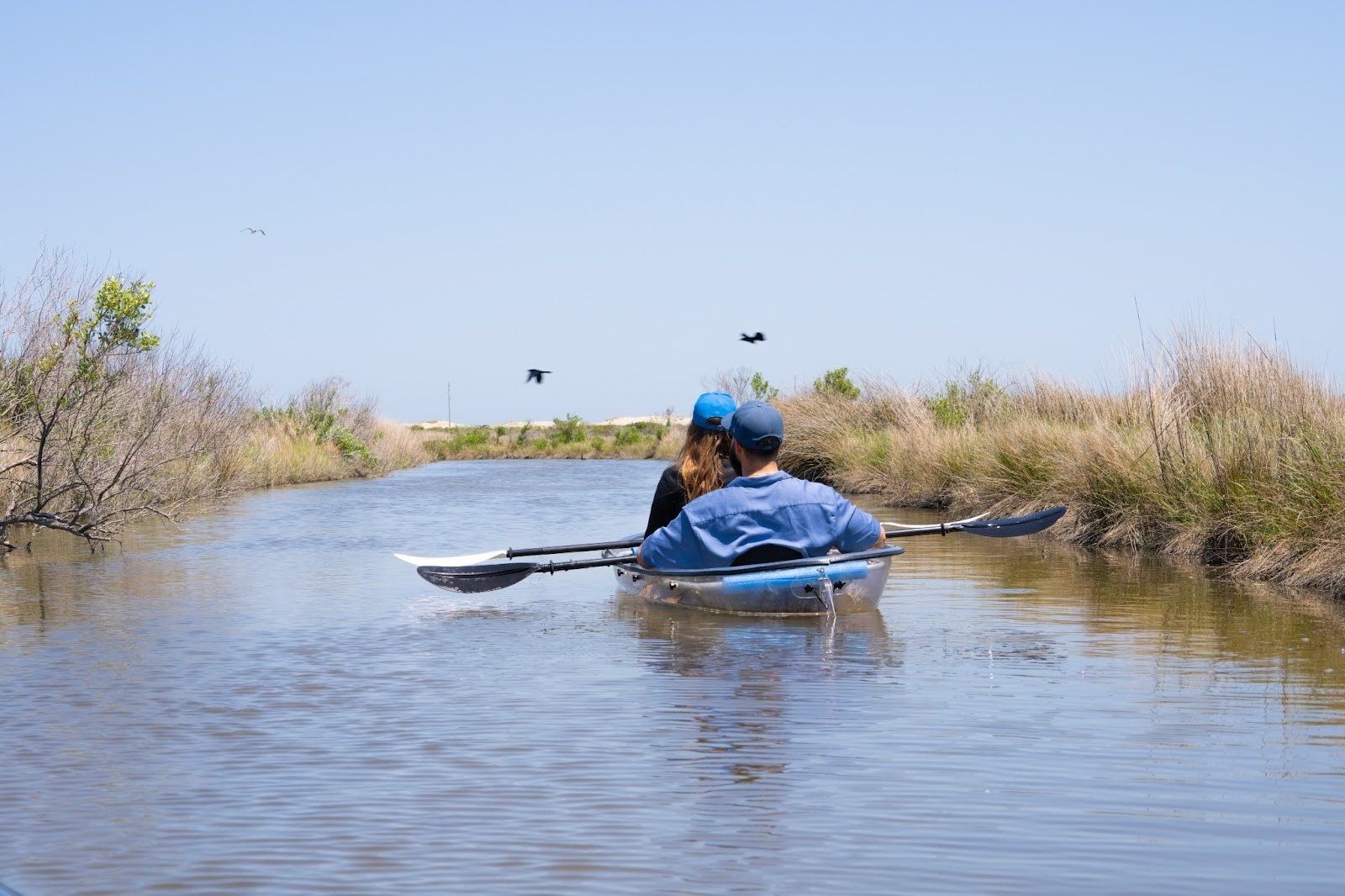Clear Kayaks, Black-and-White Beacon: A Private Paddle at Bodie Island
A quiet 1.5–2-hour glide beneath a historic lighthouse—wildlife, calm water, and crystal-clear views into the seagrass world.
The Roanoke Sound moves like a slow-breathing animal at first light—exhale, inhale, a hush draped in salt and birdsong. Marsh grass whispers against a mild breeze. A great blue heron watches your bow slide by, its neck cocked in that judgmental way herons have, as if to say: keep it quiet, keep it steady. Then the lighthouse steps in—the bold, banded tower of Bodie Island, black-and-white stripes cleaving the sky—steady as a metronome while your clear kayak drifts over eelgrass and a scattering of shells. The water under you turns into a window. A stingray flickers like a skipping stone beneath the hull and disappears, the sound teasing you forward.
Trail Wisdom
Chase morning calm
Outer Banks winds often build by midday—book an early tour for flatter water and easier paddling.
Team up your strokes
These are tandem kayaks—communicate, match cadence, and keep your blades light to minimize splash and maximize glide.
Protect your feet
Wear closed-toe water shoes; the Sound’s edges hide shells and oyster fragments that can cut bare feet.
Respect the roosts
Give birds space, especially during nesting and feeding; if a bird flies because of you, you’re too close.
Local Knowledge
Hidden Gems
- •Coquina Beach, just across NC-12 from the lighthouse—broad sand and fewer crowds
- •Pea Island National Wildlife Refuge’s North Pond Trail for a post-paddle birding walk
Wildlife
Osprey, Atlantic stingray
Conservation Note
This estuary is part of Cape Hatteras National Seashore—stay off fragile marsh edges, avoid disturbing roosting birds, and pack out all trash to protect seagrass and nursery habitats.
The current Bodie Island Lighthouse was completed in 1872, replacing two earlier towers, and historically used a first-order Fresnel lens to guide ships through the treacherous Outer Banks shoals.
Seasonal Guide
spring
Best for: Migratory bird action, Glassier morning water, Mild temps
Challenges: Variable winds, Cooler water temps
Expect lively birdlife and comfortable air; bring a light wind shell and quick-dry layers for passing breezes.
summer
Best for: Sunset color shows, Warm water, Family outings
Challenges: Heat and UV exposure, Pop-up thunderstorms, Biting flies on still days
Start early or go late for cooler air; hydrate, wear sun protection, and keep an eye on storm forecasts.
fall
Best for: Peak migration sightings, Calm, clear mornings, Lower crowds
Challenges: Remnant nor’easters, Shorter daylight
Shoulder-season paddles can be sublime—pack an extra layer and check wind direction before you launch.
winter
Best for: Solitude, Crystal air clarity
Challenges: Cold water/air, Limited tour availability during extreme weather
Dress in warm, windproof layers and choose calm-day windows; the payoff is quiet water and expansive views.
Photographer's Notes
What to Bring
Lightweight windbreakerEssential
Cuts windchill on breezy mornings without adding bulk.
Polarized sunglasses with retainerEssential
Reduces glare to help you see through the water’s surface and keeps your shades secure if splashed.
Closed-toe water shoesEssential
Protects feet during launch/landing and grips wet surfaces.
Waterproof phone case
Pairs with the provided dry bag for quick photos without risking your device.
Common Questions
Do I need kayaking experience?
No. The tour is beginner-friendly, with a guide offering basic instruction; tandem kayaks make it easy to balance and keep pace.
How long is the paddle and how many people are allowed?
Plan for 1.5–2 hours on the water. Private groups can include up to 10 paddlers.
What are the weight limits for the kayaks?
Each tandem kayak has a 425 lb combined limit and a 250 lb per-person limit.
Is alcohol allowed on the tour?
No. Alcohol is prohibited for safety.
What wildlife might I see?
Common sightings include herons, egrets, pelicans, cormorants, ospreys, turtles, and the occasional Atlantic stingray.
What should I wear?
Quick-dry clothing, sun protection, and closed-toe water shoes. Bring a light layer if it’s breezy; a dry bag is provided for small items.
What to Pack
Sun-smart layers (hat, UPF shirt), closed-toe water shoes for shell-strewn launches, a reusable water bottle to stay hydrated, and a compact windbreaker for breezy stretches.
Did You Know
The Bodie Island Lighthouse, completed in 1872, stands 156 feet tall and historically used a first-order Fresnel lens; the name traces to the Boddie family, not to shipwrecked 'bodies.'
Quick Travel Tips
Book a morning departure for calmer conditions; check wind forecasts (10–12 mph or less is ideal). Arrive 20 minutes early to gear up. Bring cash or card for the nearby park bookstore. Plan a beach stop at Coquina afterward to rinse off and relax.
Local Flavor
Post-paddle, fuel up at Sam & Omie’s near Whalebone Junction for a classic Outer Banks meal, or try Blue Moon Beach Grill in Nags Head for fresh local seafood. Beer lovers can head to Outer Banks Brewing Station in Kill Devil Hills—wind-powered and reliably lively.
Logistics Snapshot
Closest airport: Norfolk International (ORF), ~2 hours by car. Launch area: Bodie Island Lighthouse, 8210 Bodie Island Lighthouse Rd. ~15 minutes from central Nags Head. Cell service: Generally fair but can be spotty near the marsh. Permits: None required for guided tours; reservations are mandatory.
Sustainability Note
You’re paddling sensitive estuarine habitat—avoid grounding in seagrass, keep paddles shallow near oyster beds, and maintain a respectful buffer from wildlife. Refill a reusable bottle and leave only ripples.
